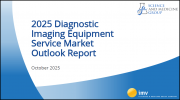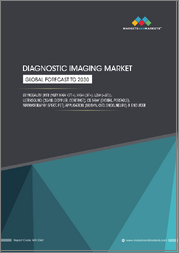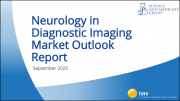
|
시장보고서
상품코드
1619019
세계의 영상 진단 서비스 시장 - 규모, 점유율, 성장 분석 : 모달리티별, 기술별, 용도별, 최종 사용자별, 지역별 산업 예측(2024-2031년)Diagnostic Imaging Services Market Size, Share, Growth Analysis, By Modality, By Technology (2D Imaging Technology, 3D/4D Imaging Technology), By Application, By End User, By Region - Industry Forecast 2024-2031 |
||||||
세계 영상 진단 서비스 시장 규모는 2022년 5,450억 달러로 평가되었고, 2023년 5,733억 4,000만 달러에서 2031년에는 8,600억 8,000만 달러로 성장해 예측 기간 중(2024-2031년)의 CAGR은 5.2%로 성장할 전망입니다.
영상 시장은 기술의 진보와 소비자의 접근성 향상으로 큰 변모를 이루고 있습니다. 건강 예방 대책에 대한 사회적 인지의 고조와 일치하고 있습니다.최신의 진단 모델은 치료비와 방사선 피폭을 최소한으로 억제하면서, 정밀도를 높이는 것을 목표로 하고 있습니다. 주목할만한 동향은보다 접근하기 쉬운 휴대용 영상 솔루션으로의 전환입니다. 과제도 남아 있습니다. 전반적으로, 조기 진단에 대한 수요 증가가 예측 기간을 통해 영상 진단 서비스 시장을 강력한 성장으로 이끌고 있습니다.
목차
소개
- 조사의 목적
- 조사 범위
- 정의
조사 방법
- 정보 조달
- 2차/1차 정보원
- 시장 규모 예측
- 시장의 전제조건과 제한
주요 요약
- 세계 시장 전망
- 공급과 수요 동향 분석
- 부문별 기회 분석
시장 역학과 전망
- 시장 개요
- 시장 규모
- 시장 역학
- 성장 촉진요인과 기회
- 억제요인과 과제
- Porter's Five Forces 분석
주요 시장 인사이트
- 중요성공요인
- 경쟁도
- 주요 투자 기회
- 시장 생태계
- 시장의 매력 지수(2023년)
- PESTEL 분석
- 거시경제지표
- 밸류체인 분석
- 가격 분석
- 특허 분석
- 사례 연구 분석
- 고객 및 구매 기준 분석
영상 진단 서비스 시장 규모 : 모달리티별, CAGR(2024-2031년)
- 시장 개요
- 자기 공명 영상(MRI)
- 초음파
- 컴퓨터 단층 촬영(CT)
- X선
- 핵의학 영상(SPECT/PET)
- 유방 조영
영상 진단 서비스 시장 규모 : 기술별, CAGR(2024-2031년)
- 시장 개요
- 2D 영상 기술
- 3D/4D영상 기술
영상 진단 서비스 시장 규모 : 용도별, CAGR(2024-2031년)
- 시장 개요
- 자기 공명 영상(MRI) 용도
- 신경학
- 정형외과
- 심장혈관
- 골반과 복부
- 종양학
- 기타 MRI 용도
- 초음파 용도
- 산부인과
- 심장혈관
- 비뇨기과
- 신경학
- 정형외과
- 기타 초음파 용도
- 컴퓨터 단층 촬영(CT) 용도
- 심장혈관
- 종양학
- 신경학
- 기타 컴퓨터 단층 촬영(CT) 용도
- X선 용도
- 일반 방사선 검사
- 치과
- 기타 X선 용도
- 핵의학 영상 서비스 용도
- 신경학
- 종양학
- 심장혈관
- 기타 핵의학 영상 용도
- 유방 조영술 응용
영상 진단 서비스 시장 규모 : 최종 사용자별, CAGR(2024-2031년)
- 시장 개요
- 병원
- 영상 진단센터
- 외래 진료 센터
- 연구와 학술
영상 진단 서비스 시장 규모, CAGR(2024-2031년)
- 북미
- 미국
- 캐나다
- 유럽
- 독일
- 스페인
- 프랑스
- 영국
- 이탈리아
- 기타 유럽
- 아시아태평양
- 중국
- 인도
- 일본
- 한국
- 기타 아시아태평양
- 라틴아메리카
- 브라질
- 기타 라틴아메리카
- 중동 및 아프리카
- GCC 국가
- 남아프리카
- 기타 중동 및 아프리카
경쟁 정보
- 상위 5개사 비교
- 주요 기업의 시장 포지셔닝(2023년)
- 주요 시장 기업이 채용한 전략
- 시장의 최근 동향
- 기업의 시장 점유율 분석(2023년)
- 주요 기업 프로파일
- 기업 개요
- 제품 포트폴리오 분석
- 부문별 점유율 분석
- 수익의 전년 대비 비교(2021-2023년)
주요 기업 프로파일
- Radnet, Inc.
- Sonic Healthcare(SHL)
- Healius Limited
- Dignity Health
- Novant Health
- InHealth Group
- Apex Radiology
- Concord Medical Services Holdings Limited
- Capitol Imaging Services
- Canada Diagnostic Centres(CDC)
- Envision Radiology
- PRP Diagnostic Imaging
- Inova
- Atlantic Medical Imaging
- Advanced Diagnostics Healthcare System, Inc.
- Radiology Partners
- Touchstone Medical Imaging
- Southwest Medical Imaging(SMIL)(Scottsdale Medical Imaging)
- Quantum Radiology
- Atlantic Medical Imaging(AMI)
- Southwest Diagnostic Imaging Center
결론과 권장사항
JHS 25.01.14Global Diagnostic Imaging Services Market size was valued at USD 545.0 billion in 2022 and is poised to grow from USD 573.34 billion in 2023 to USD 860.08 billion by 2031, growing at a CAGR of 5.2% during the forecast period (2024-2031).
The diagnostic imaging market is experiencing significant transformation driven by advancements in technology and increased consumer access. Techniques like X-rays, ultrasounds, CT scans, and MRIs are crucial for accurate diagnosis and early disease detection, aligning with the growing public recognition of health proactive measures. Modern diagnostic models aim to enhance precision while minimizing treatment costs and radiation exposure. A notable trend is the shift towards portable imaging solutions that facilitate greater accessibility. However, challenges remain, particularly in low-income countries where unfavorable reimbursement structures for outpatient imaging services could hinder market expansion. Overall, the increasing demand for early diagnosis positions the diagnostic imaging services market for robust growth throughout the forecast period.
Top-down and bottom-up approaches were used to estimate and validate the size of the Global Diagnostic Imaging Services market and to estimate the size of various other dependent submarkets. The research methodology used to estimate the market size includes the following details: The key players in the market were identified through secondary research, and their market shares in the respective regions were determined through primary and secondary research. This entire procedure includes the study of the annual and financial reports of the top market players and extensive interviews for key insights from industry leaders such as CEOs, VPs, directors, and marketing executives. All percentage shares split, and breakdowns were determined using secondary sources and verified through Primary sources. All possible parameters that affect the markets covered in this research study have been accounted for, viewed in extensive detail, verified through primary research, and analyzed to get the final quantitative and qualitative data.
Global Diagnostic Imaging Services Market Segmental Analysis
Global Diagnostic Imaging Services Market is segmented by modality, technology, application, end user and region. Based on modality, the market is segmented into magnetic resonance imaging (MRI), ultrasound, computed tomography (CT), X-Ray, nuclear imaging (SPECT/PET) and mammography. Based on technology, the market is segmented into 2D imaging technology and 3D/4D imaging technology. Based on application, the market is segmented into Magnetic Resonance Imaging (MRI) Applications, Ultrasound, Computed Tomography (CT) Applications, X-Ray Applications, Nuclear Imaging Services Applications, and Mammography Application. Based on end user, the market is segmented into hospitals, diagnostic imaging centers, ambulatory care centers and research & academia. Based on region, the market is segmented into North America, Europe, Asia Pacific, Latin America and Middle East & Africa.
Driver of the Global Diagnostic Imaging Services Market
One of the key drivers of the Global Diagnostic Imaging Services market is the increasing elderly population, which significantly amplifies the need for diagnostic imaging procedures. As this demographic grows, so does the likelihood of chronic health conditions such as cancer, cardiovascular diseases, kidney diseases, and spinal disorders, which necessitate frequent imaging assessments. Research from the National Institutes of Health indicates that individuals over 65 undergo diagnostic imaging at rates that are two to three times higher than those of younger individuals. This demographic shift leads to an escalating demand for varied diagnostic imaging services, thereby stimulating growth within the market.
Restraints in the Global Diagnostic Imaging Services Market
The Global Diagnostic Imaging Services market faces significant constraints due to the high costs associated with purchasing and installing diagnostic imaging systems. Healthcare facilities, especially outpatient imaging centers, often depend on external payers to recover the expenses incurred from diagnostic and screening services using these costly systems. Consequently, the persistent decline in reimbursement rates for diagnostic imaging scans, coupled with the escalating prices of advanced imaging technologies, poses a significant barrier for small to medium-sized imaging facilities. This limitation hinders their ability to invest in cutting-edge diagnostic modalities, ultimately stifling market growth throughout the analysis period.
Market Trends of the Global Diagnostic Imaging Services Market
The Global Diagnostic Imaging Services market is experiencing a significant upward trend, fueled by the increasing introduction and adoption of open diagnostic imaging technologies. These innovative services cater specifically to the complexities associated with imaging overweight and obese patients, thereby enhancing accessibility and comfort. As healthcare providers recognize the importance of accommodating diverse patient needs, the demand for more inclusive imaging solutions is propelling market growth. This shift not only improves patient experience but also optimizes diagnostic accuracy, positioning open imaging services as a pivotal factor in the evolving landscape of diagnostic healthcare.
Table of Contents
Introduction
- Objectives of the Study
- Scope of the Report
- Definitions
Research Methodology
- Information Procurement
- Secondary & Primary Data Methods
- Market Size Estimation
- Market Assumptions & Limitations
Executive Summary
- Global Market Outlook
- Supply & Demand Trend Analysis
- Segmental Opportunity Analysis
Market Dynamics & Outlook
- Market Overview
- Market Size
- Market Dynamics
- Drivers & Opportunities
- Restraints & Challenges
- Porters Analysis
- Competitive rivalry
- Threat of substitute
- Bargaining power of buyers
- Threat of new entrants
- Bargaining power of suppliers
Key Market Insights
- Key Success Factors
- Degree of Competition
- Top Investment Pockets
- Market Ecosystem
- Market Attractiveness Index, 2023
- PESTEL Analysis
- Macro-Economic Indicators
- Value Chain Analysis
- Pricing Analysis
- Patent Analysis
- Case Study Analysis
- Customer & Buying Criteria Analysis
Global Diagnostic Imaging Services Market Size by Modality & CAGR (2024-2031)
- Market Overview
- Magnetic Resonance Imaging (MRI)
- Ultrasound
- Computed Tomography (CT)
- X-Ray
- Nuclear Imaging (SPECT/PET)
- Mammography
Global Diagnostic Imaging Services Market Size by Technology & CAGR (2024-2031)
- Market Overview
- 2D Imaging Technology
- 3D/4D Imaging Technology
Global Diagnostic Imaging Services Market Size by Application & CAGR (2024-2031)
- Market Overview
- Magnetic Resonance Imaging (MRI) Applications
- Neurology
- Orthopedics
- Cardiovascular
- Pelvic & Abdomen
- Oncology
- Other MRI Applications
- Ultrasound Applications
- Obstetrics & Gynecology
- Cardiovascular
- Urology
- Neurology
- Orthopedics
- Other Ultrasound Applications
- Computed Tomography (CT) Applications
- Cardiovascular
- Oncology
- Neurology
- Other Computed Tomography (CT) Applications
- X-Ray Applications
- General Radiography
- Dentistry
- Other X-Ray Applications
- Nuclear Imaging Services Applications
- Neurology
- Oncology
- Cardiovascular
- Other Nuclear Imaging Applications
- Mammography Applications
Global Diagnostic Imaging Services Market Size by End User & CAGR (2024-2031)
- Market Overview
- Hospitals
- Diagnostic Imaging Centers
- Ambulatory Care Centers
- Research & Academia
Global Diagnostic Imaging Services Market Size & CAGR (2024-2031)
- North America (Modality, Technology, Application, End User)
- US
- Canada
- Europe (Modality, Technology, Application, End User)
- Germany
- Spain
- France
- UK
- Italy
- Rest of Europe
- Asia Pacific (Modality, Technology, Application, End User)
- China
- India
- Japan
- South Korea
- Rest of Asia-Pacific
- Latin America (Modality, Technology, Application, End User)
- Brazil
- Rest of Latin America
- Middle East & Africa (Modality, Technology, Application, End User)
- GCC Countries
- South Africa
- Rest of Middle East & Africa
Competitive Intelligence
- Top 5 Player Comparison
- Market Positioning of Key Players, 2023
- Strategies Adopted by Key Market Players
- Recent Developments in the Market
- Company Market Share Analysis, 2023
- Company Profiles of All Key Players
- Company Details
- Product Portfolio Analysis
- Company's Segmental Share Analysis
- Revenue Y-O-Y Comparison (2021-2023)
Key Company Profiles
- Radnet, Inc.
- Company Overview
- Business Segment Overview
- Financial Updates
- Key Developments
- Sonic Healthcare (SHL)
- Company Overview
- Business Segment Overview
- Financial Updates
- Key Developments
- Healius Limited
- Company Overview
- Business Segment Overview
- Financial Updates
- Key Developments
- Dignity Health
- Company Overview
- Business Segment Overview
- Financial Updates
- Key Developments
- Novant Health
- Company Overview
- Business Segment Overview
- Financial Updates
- Key Developments
- InHealth Group
- Company Overview
- Business Segment Overview
- Financial Updates
- Key Developments
- Apex Radiology
- Company Overview
- Business Segment Overview
- Financial Updates
- Key Developments
- Concord Medical Services Holdings Limited
- Company Overview
- Business Segment Overview
- Financial Updates
- Key Developments
- Capitol Imaging Services
- Company Overview
- Business Segment Overview
- Financial Updates
- Key Developments
- Canada Diagnostic Centres (CDC)
- Company Overview
- Business Segment Overview
- Financial Updates
- Key Developments
- Envision Radiology
- Company Overview
- Business Segment Overview
- Financial Updates
- Key Developments
- PRP Diagnostic Imaging
- Company Overview
- Business Segment Overview
- Financial Updates
- Key Developments
- Inova
- Company Overview
- Business Segment Overview
- Financial Updates
- Key Developments
- Atlantic Medical Imaging
- Company Overview
- Business Segment Overview
- Financial Updates
- Key Developments
- Advanced Diagnostics Healthcare System, Inc.
- Company Overview
- Business Segment Overview
- Financial Updates
- Key Developments
- Radiology Partners
- Company Overview
- Business Segment Overview
- Financial Updates
- Key Developments
- Touchstone Medical Imaging
- Company Overview
- Business Segment Overview
- Financial Updates
- Key Developments
- Southwest Medical Imaging (SMIL) (Scottsdale Medical Imaging)
- Company Overview
- Business Segment Overview
- Financial Updates
- Key Developments
- Quantum Radiology
- Company Overview
- Business Segment Overview
- Financial Updates
- Key Developments
- Atlantic Medical Imaging (AMI)
- Company Overview
- Business Segment Overview
- Financial Updates
- Key Developments
- Southwest Diagnostic Imaging Center
- Company Overview
- Business Segment Overview
- Financial Updates
- Key Developments



















